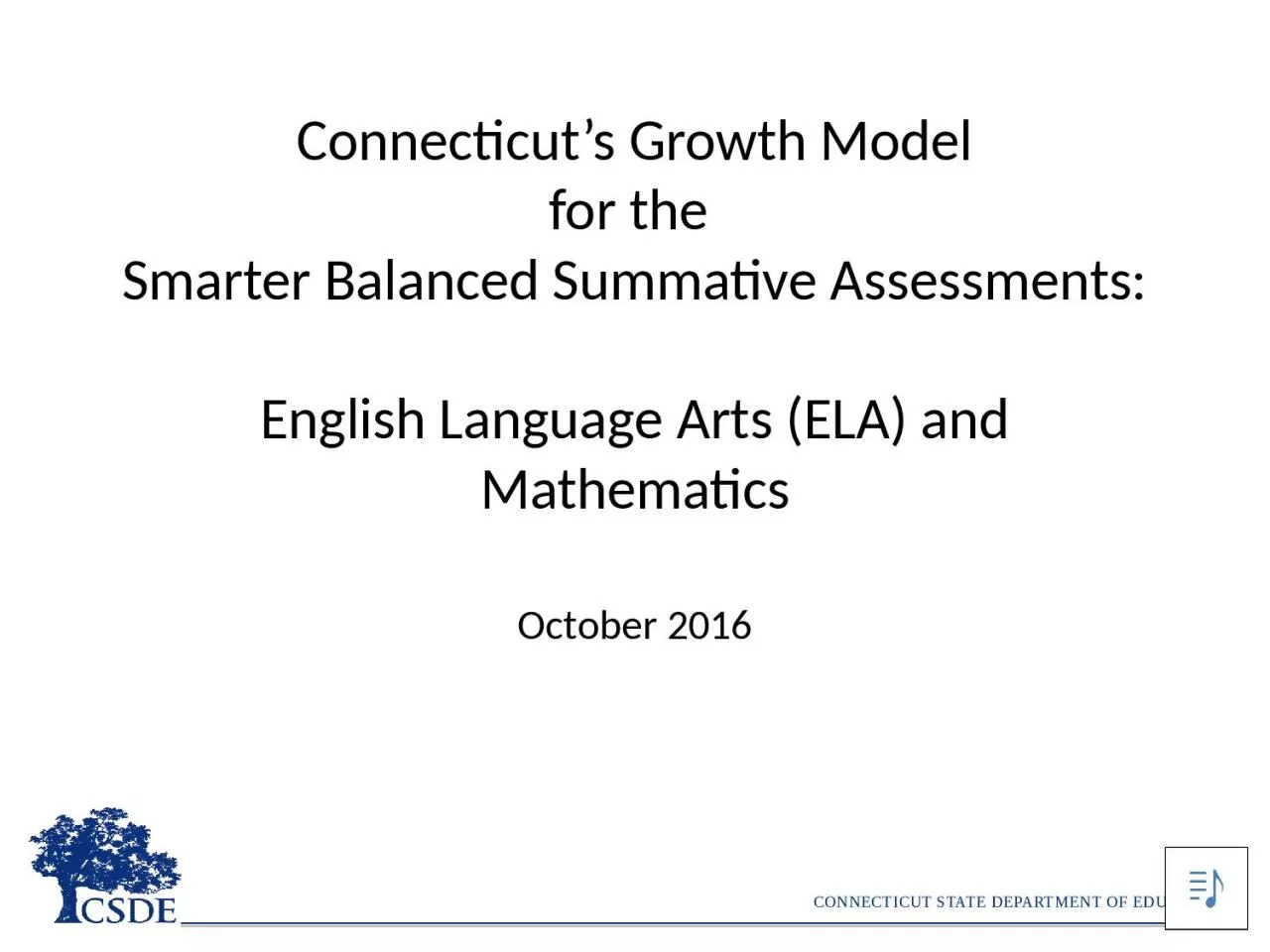

for the Smarter Balanced Summative Assessments English Language Arts ELA and Mathematics October 2016 1 Agenda What is growth How is it different from achievement What is Connecticuts approach to measuring growth ID: 1026397
Download Presentation The PPT/PDF document "Connecticut’s Growth Model" is the property of its rightful owner. Permission is granted to download and print the materials on this web site for personal, non-commercial use only, and to display it on your personal computer provided you do not modify the materials and that you retain all copyright notices contained in the materials. By downloading content from our website, you accept the terms of this agreement.
1. Connecticut’s Growth Modelfor the Smarter Balanced Summative Assessments:English Language Arts (ELA) and MathematicsOctober 20161
2. AgendaWhat is growth? How is it different from achievement?What is Connecticut’s approach to measuring growth?What factors are considered when establishing ambitious yet achievable targets?How and when will growth be incorporated into the Next Generation Accountability System for districts and schools?2
3. What is growth? How is it different from achievement?Achievement or Proficiency:A one-time snapshot measurement of a student’s academic performanceGrowth:Change in achievement score for the same student between two or more points in time.3
4. Three Ways to Understand Change in Performance4Achievement Change“Rough Cohort” ChangeMatched Student Cohort Growth What is it?How does it work?Compares student achievement across years (e.g., achievement of grade 4 students in 2014-15 is compared to the achievement of grade 4 students in 2015-16)Compares the achievement of a group of students from one grade in year 1 to a group of students in the next higher grade in year 2 (e.g., grade 3 in 2014-15 to grade 4 in 2015-16)Compares the achievement of the same student from one grade in year 1 to the next higher grade in year 2 (e.g., student in grade 3 in 2014-15 to grade 4 in 2015-16)Who is compared?Different students across different yearsMostly the same students though there can be some mismatches due to student mobility, entry, and exitThe same students from one year to the next… no mismatchesWhat is measured?Proficiency rate (e.g., percent at or above level 3) and/or average scale scoresProficiency rate (e.g., percent at or above level 3) and/or average scale scoresThe amount of growth to standard achieved by each student and groups of studentsWhat does it offer?The starting point for understanding changeA “rough estimate” of growthThe gold standard for growth and for understanding curricular and instructional effectiveness
5. What is Connecticut’s approach to measuring growth?Similar to approach used with CMT growth modelCriterion referencedUses Smarter Balanced vertical scale that spans grades/yearsPreserves achievement level concept for interpretabilityProvides ambitious yet achievable individual student targetsExpects all students to grow, including those performing in Levels 3 and 4Can be aggregated for group level resultsReviewed by Connecticut Technical Advisory Committee5
6. What factors are considered when establishing ambitious yet achievable targets?Empirical: What is the actual growth achieved by students performing at different segments of the vertical scale?Measurement Error: Does the growth expectation exceed the pooled average measurement error from both year 1 and year 2 assessments?Time: Are students on a path to higher levels of achievement in the future?6
7. Grade in Yr. 1LevelLevel 1: Not MetLevel 2: ApproachingLevel 3: MetLevel 4: Exceeded1 - LOW2 - HIGH3 - LOW4 - HIGH5 - LOW6 - HIGH7 - LOW8 - HIGH3Range2114-23302331-23662367-23992400-24312432-24602461-24892490-25222523+Target8271706968646045/maintain4Range2131-23782379-24152416-24442445-24722473-25022503-25322533-25682569+Target8269696458554934/maintain5Range2201-24052406-24412442-24712472-25012502-25412542-25812582-26192620+Target6956554843393016/maintain6Range2210-24172418-24562457-24932494-25302531-25742575-26172618-26562657+Target7358534744383321/maintain7Range2258-24382439-24782479-25152516-25512552-26002601-26482649-26872688+Target6950494440312012/maintain8Range2288-24462447-24862487-25262527-25662567-26172618-26672668-27032704+ELA Achievement Level Ranges and Growth Targets7
8. Grade in Yr. 1LevelLevel 1: Not MetLevel 2: ApproachingLevel 3: MetLevel 4: Exceeded1 - LOW2 - HIGH3 - LOW4 - HIGH5 - LOW6 - HIGH7 - LOW8 - HIGH3Range2189-23512352-23802381-24082409-24352436-24682469-25002501-25262527+Target7761596059575647/maintain4Range2204-23812382-24102411-24472448-24842485-25162517-25482549-25742575+Target5138404446474337/maintain5Range2219-24192420-24542455-24912492-25272528-25532554-25782579-26052606+Target4346454442414144/maintain6Range2235-24342435-24722473-25122513-25512552-25802581-26092610-26392640+Target4941383636363831/maintain7Range2250-24382439-24832484-25252526-25662567-26002601-26342635-26642665+Target5835313136373835/maintain8Range2265-24562457-25032504-25442545-25852586-26192620-26522653-26852686+Math Achievement Level Ranges and Growth Targets8
9. 9
10. Two Aggregate Outcome Metrics10Growth Rate Percentage of Target AchievedMeasure?Percentage of students meeting their respective growth targetAverage percentage of growth target achieved for all studentsPrecision?Binary (yes/no), less preciseBased on scale score, more preciseContinuous?No. Students nearly meeting target will be deemed not meeting targetYes. Students get “credit” for any growth up to and beyond the targetInterpretability?Simple to understandMore nuancedUses?Reporting onlyReporting and district/school accountability
11. How and when will growth be incorporated into the Next Generation Accountability System?Growth (Indicator 2) will be added to the system starting with the 2015-16 results.As with achievement, Growth (Indicator 2) points are awarded for All Students and High Needs groups.The points for Achievement (Indicator 1) will be halved for any school with Growth results.Growth will carry slightly more weight in the model than Achievement.In light of the discontinuance of the ELA Performance Task in February 2016, the rescored 2014-15 ELA scores that were based on the Computer-Adaptive Test (CAT) only will be used as the ELA baseline for an apples-to-apples comparison.11
12. What about other factors like poverty, language ability, or disability?The CSDE is not using a value-added approach to adjust targets or evaluate growth relative to some preconceived expectation based on student characteristics of what a student can achieve or how much he/she can grow.The CSDE is not setting different targets for different students. All students at a prior achievement range will have the same growth amount expectation. 12
13. Not All Growth Models are Value-AddedThe terms “growth model” and “value-added” are often used interchangeably. But Value-Added is only one of several types of models that measure student growth. It is also the only model designed to determine which aspect of schooling (e.g., school, teacher, education program) is responsible for a students' growth. (Center for Public Education).Value-added models are focused on the effects of teachers and leaders… on student score gains. They address whether students grew more or less than expected. (O’Malley, McClarty, Magda, and Burling, 2011)13
14. SummaryCriterion referenced: does not depend on how others doContinuous: all growth counts; no golden bandsFamiliar: similar to approach used with CMTTransparent: easily replicable; no “black-box” adjustmentsCollaborative: transparency allows for conversation/reflectionFair: excludes “partial-year” studentsAchievable: based on actual growth of Connecticut studentsAmbitious: encourages growth above target14